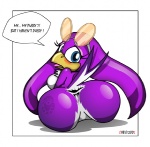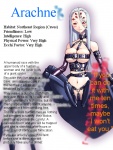Help: Translation Guidelines
翻訳は難しいね?
As e621 is an art archive that's host to creators, consumers, and creations using many different languages, one good way to contribute is to create quality translations for non-English content. While it isn't particularly important to the wider community, there are also users who enjoy translating things into non-English languages. This page will cover how to work on quality translations, how to create tags for non-English characters, and more.
Table of Contents
Translation Policy, Summarized
- In the interest of creating high-quality translations, you should:
- avoid submitting trivial, low-quality, or incorrect translation notes, description translations, and image edits.
- add translation check or description check to posts where you are uncertain of your work.
- double-check and edit all translations you get from tools such as dictionaries, optical character recognition, or machine translators.
- In the interest of allowing e621's translation community to collaborate peacefully and effectively, you should:
- avoid "edit-warring" in translation notes and descriptions.
- avoid submitting translations to non-English languages, except in the form of a comment.
- provide detailed explanations when you correct another user's work.
- In the interest of improving tagging and searchability, you should follow the Name Translation Style Guide:
- check authoritative sources (including high-quality fan-translated media, if it is known to exist) to generate character tags and copyright tags.
- review artist usernames across various social networks, or use more conventional translation or transliteration, to generate artist tags.
e621 Translation Staff
The following staff members have volunteered to address translation-related issues and to add language resources to this page.
- Japanese
- Russian
Machine Translations
Machine translations will generally be treated as low-quality translations, if their mechanical origin is immediately obvious to others.
- Machine translators may simply translate words incorrectly (transforming positive verb forms into negative verb forms, transforming words into names, and similar).
- Machine translators are blind to context.
- Machine translators take a very, very long time to learn slang.
- Machine translators do not play well with genderless language or pro-drop languages, such as using pronouns that are known to be incorrect when viewing the image.
- Machine translators can, due to how they compare your input against manual translations, return sentences that are completely and utterly irrelevant.
- In particular, DeepL likes to return nonsense phrases like " I'm not sure if it's a good idea, but it's a good idea. "
- Machine translators do not understand when something is worded strangely.
- Machine translators do not create translator's notes, and can't communicate minor details like homophones or rhymes.
Machine translations may be sufficient for extremely simple text where a human translator would return a similar result, such as simple words, idioms, and phrases with centuries of prior usage. However, users who tend to resort to machine translation might not know the source language well enough to determine when these kinds of trivially-translated phrases are in use. Essentially, users should be extremely wary of submitting translations that are mechanical in origin, and adding translation check is usually a pretty good idea.
Translation Edits of Images and Videos
In some cases, a translator might prefer to convey their translation by posting a translation edit of the image/video. When done competently, this can be an interesting way to present a translation, as image/video editing software gives you a lot of creative control that isn't available in DText. While translation edits are generally nice for users who're just interested in looking at nice art, they're kind of a pain for translators looking to correct you or check your work, and janitors who need to determine whether your work satisfies the quality requirements. Translation edits need to provide an accurate English interpretation of the text or audio, and be a high-quality, non-trivial edit. Unless your translation edit satisfies both requirements, your post may be subject to deletion or replacement.
To provide some examples of bad translation edits:
- Annoying third-party signatures.
- While the pixel typeface is a cute little detail, it's not especially readable and it is dissimilar to the handwritten text that the original Japanese version uses.
- The backdrop for the text is extremely simplistic, and it does not take much effort for other users to edit together a much better version.
- Incorrect translation.
- Lower quality JPG version of art where an official PNG version exists.
- Questionable typesetting that makes a major part of the text difficult to read through (black text with no outline against off-black artwork.)
- Instead of redrawing the art covered by the text, the editor has chosen to blur large parts of the image.
- While at the time of posting, this edit was based on the best available version, the artist made an updated, larger version available several years later. As a consequence, this translation edit is permanently based on an inferior version.
Formatting Tricks and Templates
Descriptions and Translated Descriptions
It is common for creators to communicate additional information about their work and their characters through written text that isn't contained in the image itself. This includes text in tweets, and titles/descriptions on more traditional art galleries. For example, a creator might reveal that their character is canonically transgender. In the interest of solving disagreements about lore tags, it may be appropriate to translate descriptions relevant to the piece or the character.
In post #1553845, for example, the character's name is given in Japanese, and their canonical gender is also mentioned. Descriptions and text, translated or otherwise, is generally treated as irrelevant when tagging Tag What You See-related knowledge; it is incorrect to tag the character as an andromorph unless they appear sufficiently masculine and there is evidence of them having a pussy, but andromorph_(lore) is correct whenever the andromorph tag does not apply.
Below is a template you might use for translated descriptions. If the description is especially long, consider removing ,expanded.
[i]Title/description from (source):[/i] [section,expanded=Title in source language, or "(source language) Description"] [/section] [section,expanded=Title in English, or "Translated Description"] [/section]
Transcribing Uncommon Symbols
Some creators are very particular about the use of symbology in their text, peppering dialogue with hearts to indicate attraction, arousal, and other things besides. While there's a small range of symbols that are standardized on most keyboards, and one can theoretically memorize the "alt code" for every single variation of a heart, another option is to use an Input Method Editor.
In a Japanese IME, you can type in many words to get options relevant to that word. Below are a few examples.
| Japanese IME Input | Japanese Transliteration | Meaning | Examples |
|---|---|---|---|
| kigou | 記号 | symbols | 〠, 〽, ㊷ |
| ha-to | ハート | heart | ♡, ♥, ❤ |
| onpu | 音符 | musical note | ♪, ♫, ♬ |
| emoji | 絵文字 | pictoral symbols | ☺, ☝, 🍣 |
| nezumi | 鼠 | rats, mice | 🐀, 🐁, 🐭, 🐹 |
| kao | 顔 | faces | \(^o^)/, ( ಠ益ಠ), σ(・▽・;) ? |
Translator's Notes
Sometimes, you'll run into a case where there's just no way to intuitively express something 1:1 in English, or you feel you don't have an elegant way to communicate inside information.
When editing a note, you can add text surrounded by [sub][/sub] tags to make that text appear smaller. [sub]TN: "Keikaku" means "plan".[/sub] will appear as TN: "Keikaku" means "plan". A more detailed explanation of the formatting options available in notes is available at e621:dtext.
Name Translation Style Guide
Artist Names
1. Artist names generally do not require translations, and if direct transliteration proves difficult (such as using characters where the intended pronunciation is ambiguous), the best practice is frequently to look for romanized display names (Twitter usernames, Furaffinity usernames, etc.).
2. If the artist prefers a specific romanization, use it unless something makes that impractical.
3. Suffixes like _(artist) might be used if the artist identifies by a particularly common word.
Character Names
English names from authoritative sources are preferred, if they are known to exist. Communities generally have the right to determine what an "authoritative" name for their characters is. If a particular translation sees consistent use on other sites, it's probably valid as a tag name (or it might be worth turning into an alias.)
- Some communities adopt highly transformative localized names made for the purpose of preserving or adding wordplay. In this case, the JP names are aliased to the EN ones once they are made available.
- the Ace Attorney series.
- Starting in 2013, a fan translation for Ace Attorney Investigations 2 was created, establishing names including "Justine Courtney" and "Sebastian Debeste". Following an official 2024 release, Capcom established new localized names for these characters.
- the Dragon Quest series.
- the Mother/Earthbound series, including the fan translation for Mother 3.
- In some cases, a character's name may have multiple plausible transliterations. In this case, one name is chosen and the others are aliased to it, and the alias may change to reflect authoritative sources.
- マルス (Mars, Marth) from Fire Emblem.
- クレス・アルベイン (Cress Albane, Cless Alvein) from Tales of Phantasia.
- In rare cases, the "authoritative" name may differ from whatever name is officially used by English-speaking publishers.
- キラークイーン (Killer Queen) is localized as "Deadly Queen" in English Jojo's Bizarre Adventure media. In this case, the Japanese can be directly transliterated into English, and the localization removes a deliberate musical reference.
- ガンツ (Guntz) is localized as "Gantz" in the international version of Klonoa 2: Dream Champ Tournament. In this case, the localization removes what is understood to be a reference to the character's association with guns.
- If a character's name is a literal descriptor with no embellishments, you may consider using the literal description.
- Fox (Persona 4)
- Bibi (o-den) was once known as "failure succubus".
- In all of the above cases, if a suffix is necessary to disambiguate the tag, use the artist's name, the name of the media the character is from, or a convenient and well-understood shortening.
Copyright Names
English titles from authoritative sources are preferred, if they are known to exist. Communities generally have the right to determine what an "authoritative" name for their media is. If a particular translation sees consistent use on other sites, it's probably valid as a tag name (or it might be worth turning into an alias.)
- キミガシネ has the connotation of "you in particular, die!", but is commonly known as "Your Turn to Die" following a fan translation establishing the title (and then working officially with the creator on a Steam release.)
- 戦国武将姫Muramasa has no official English release, but the publisher's English website calls it "Muramasa: Princess Commander".
- In some cases, a piece of media might have an English subtitle (ハルキの最大の敵は理性。 TWO BEASTS OR NOT TO BEAST!!). The subtitle should not automatically be treated as an English translation, but sometimes communities attach to these subtitles regardless.
Adding Non-English Translations
In general, translations to non-English languages should not exist in posts, notes, or post descriptions. The least disruptive way to include translations of this nature is to write a comment. You may consider using the following template.
I have translated this post to (target language).
[section=日本語訳 ("x Translation" in your target language)]
[/section]
[section=日本語説明 ("x Description" in your target language)]
[/section]
Handling Bad Translations
If you are especially competent in a particular language, you may occasionally find translations that include errors. In this case, it is usually necessary to explain corrections for the benefit of users with lower proficiency (or none at all!) in that language. Depending on the nature of the errors, you have two options.
Comment Corrections
In the case that a translation is largely incorrect, you may need to create a comment where you explain the errors in detail, and possibly even provide a transcript and sources so that people less proficient in the language can confirm the nature of the error.
Suppose you have a Japanese post that depicts an anthro presenting their breasts. The Japanese text reads:
はぁ?ムネを触りたい…?
軽く触れるだけなら…
チョットだけですからね!!
But somebody has added a translation that reads:
You want to touch my...breasts?
Well, only for a little...
Hey wait a second!!
A reasonably competent Japanese-speaker should recognize this translation as being incorrect. In this case, the ideal solution is to transcribe the text and explain the errors made in the previous translation. This provides an explanation for people who are curious about the previous translation, and as you do this over time, you can eventually build a case if you happen to notice that one translator is constantly making errors. Such a comment might look like this:
Transcript
はぁ?ムネを触りたい…?
軽く触れるだけなら…
チョットだけですからね!!This translation skips over the 「軽く触れるだけなら…」 line and adds one that wasn't even there in the original text. 軽く触れる is "to be touched lightly", だけ is something like the English "only"/"just", and なら is used to set a condition for the following text. Thus, "If they are only touched lightly". This phrasing is nowhere to be found in the translation, and has instead been replaced with "Well, only for a little...". This is incorrect because "for a little" suggests a temporal limitation on how much one is allowed to touch.
That translation more closely matches the third line in the Japanese text, which is チョットだけですからね. チョット here is "a little bit", だけ is, again, "only"/"just", and ですからね is the copula. On its own, チョット is perfectly fine to interpret as a command to wait, since Japanese tends to allow implicit context far more than English does. However, context for that word is already provided by the rest of the line, which shows that the text should instead be "then only for a little bit". We can link this to the second line since it trails off with the hypothetical なら, and interpret the combined phrases as "If they are touched only lightly, then only for a little bit."
However, the previous translator has chosen to interpret チョット as a command and ignore the entire rest of the sentence, inserting an entirely new line that is nowhere present in the original text.
Translator's Note Corrections
In the case that a translation is partially correct, but is failing to communicate some particularly important information (such as grammatical quirks, things that a native speaker/native resident of another country might understand, etc.), you might simply correct the issue and then add a Translator's Note in your edit with [sub][/sub] tags.
To provide another Japanese→English example, consider this hypothetical post: An image of a dog squatting, looking up with pleading eyes and an erect penis. There is a speech bubble coming from an off-screen character that says 「ちんちん!」. Somebody has added a translation note that says:
Dick!
While in the strictest sense, this translation is at least partially correct, there's a subtlety here that non-Japanese-speakers are not likely to grasp. It would be appropriate to revise the note to say:
Beg! In Japanese, "chinchin" means both "penis" and "beg (in the sense of an animal begging.)"
In spite of the translation note change, the new version still conveys some of the previous translator's knowledge and intent. In most cases, something like this should be sufficient to resolve the translation issues without requiring staff intervention.
Handling Abusive Translators
In the case of a translator who is exhibiting certain abusive behaviors, you may wish to file a report against that user. Depending on severity, staff members may either speak privately to a translator about the quality of their work, delete posts, or take action against that translator's account. In particular, the following may warrant staff intervention:
- "Edit-warring" in notes.
- On English posts, adding notes with non-English translations.
- On non-English posts, replacing English translations with non-English translations.
- Repeatedly insisting on a specific translation without sufficient justification.
- Consistently submitting low-quality or trivial translation edits.
- Submitting low-quality/machine translations without using translation check.
You should explain the issue thoroughly when submitting your report. If you and other users are diligently submitting well-explained corrections, you can direct staff towards those corrections, or you might explain incorrect translations in your tickets. If you are looking to write detailed explanations in your ticket, note that there is a character limit on tickets that may make it impractical to explain mistranslations across a large number of posts.
Resources
Provided here is a list of resources for certain languages. While we cannot necessarily teach our users new languages, dictionaries and other such resources are frequently useful in the case of single words, short phrases, and more obscure terms.
If you have a resource that you would like to add to this list, send a dmail to a translation staff member.
East Asian Languages (Chinese, Japanese, Korean, etc.)
Chinese Resources
Japanese Resources
Korean Resources
Germanic Languages (English, German, Dutch, etc.)
Romance Languages (French, Italian, Spanish, etc.)
Other sections/language groupings to be added as needed.





